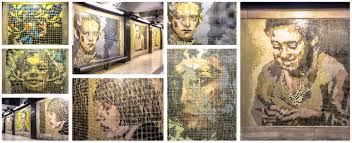Estación Callao
- Caitlin Pearson
- Jul 28, 2019
- 2 min read
Serie Incendio en el Castillo (Fire series in Immendorf Castle), Remo Bianchedi
I was captivated by these massive murals in this station. There are eight total, 4 on each side of the subway wall. The walls are slightly curved in giving the murals more dimension. These pieces definitely scream “hey, notice me!”, due to how unique they are in comparison to other pieces of art throughout the subway. One, it is not on tiles and two, it is not placed on the flat Subté walls. The whole infrastructure of the station is built around these pieces. They were so prominent that they caught my attention through the windows of speeding subway cart and through all the crammed people between me. I knew I had to go back to the station and check them out.
The artist, Remo Bianchedi, used over 15 thousand mosaic pieces or ‘venecitas’* to create these gorgeous mosaics. Five of the portraits are to “[reflect] the look of a child in the moment before the fire of the [Immendorf] castle that hosted the works by Gustav Klimt”. The works by Klimt were placed in the castle in Austria for protection but in 1945, the were burned along with the rest of the castle by the German SS forces. The other 3 murals (“No More Tears”, “Crows”, and “Sofia” are to display the reactions of the end of World War II. Bianchedi was heavily influences by Klimt and Joseph Bueys, who was actually Bianchedi’s teacher in higher education.
Facial expressions convey so much emotion. Although these faces tend to not be exaggerative expressions, it is clear there is a sense of either mourning, anger, shock, or even happiness. It not clear exactly why these people feel this way (exception of the fire series) but I can only imagine what they saw, what they faced, or what made them smile. This is the mystery of life.
*venecitas: ventana in Spanish means window; and often times Spanish speakers use the endings “cita” or “ita” to distinguish affection or a small item. So the literal translation of small mosaic pieces in this context is small windows. How fitting!




Comments